What is the Equator?
 Michael Anissimov
Michael Anissimov
The equator is an imaginary line that divides the Earth into the Northern Hemisphere and Southern Hemisphere. Its length is about 24,901.5 miles (40,075 kilometers). The line crosses the continents of South America and Africa, as well as a number of islands, and runs through 14 countries, including Ecuador, Columbia, Brazil, Gabon, São Tomé and Príncipe, Congo, Zaire, Uganda, Kenya, Somalia, and Indonesia. The location of this imaginary line is indicated in many areas, making it possible to stand with a foot in each hemisphere. The geographical areas surrounding it are known as the equatorial regions, and they have a particular type of climate.
Latitude and Longitude
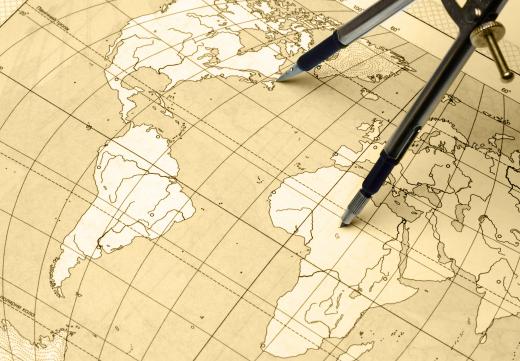
The location of any point on the Earth can be defined by its latitude and longitude, given in degrees (°). Lines of longitude all run from pole to pole, and they are all roughly the same length but are not parallel, as they converge towards the poles. Lines of latitude run at right angles to the longitude lines and are parallel, but they diminish in length towards the poles. The equator is at 0° latitude and is the longest such line, representing the circumference of the Earth. When a latitude for a location not on the equator is given, it is necessary to specify whether it is north or south of this line.
Day Length and Seasons
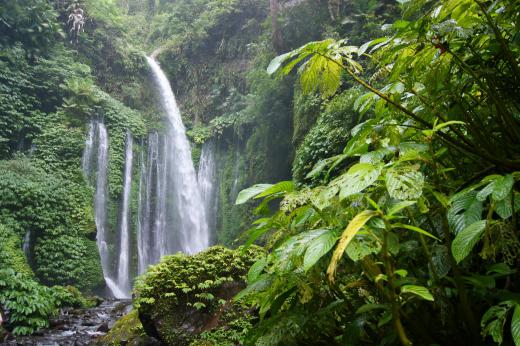
Due to the fact that the Earth wobbles slightly on its axis through the year, the higher latitudes experience summer and winter seasons, as well as variations in day length. At the equator, however, the effects of this wobbling are minimal. As a result, the region experiences 12 hours of daylight throughout the year and does not have clearly defined seasons, at least in terms of temperature.
Climate
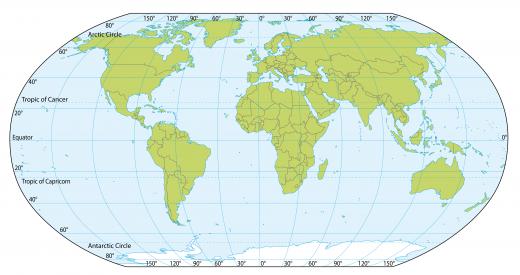
The equatorial regions receive more heat from the Sun than any other area of the Earth’s surface, and heating of the atmosphere in these regions drives the world’s climate system. Warm air, which also contains a lot of moisture from the ocean, rises near the equator, flows outwards at high altitude, and descends again at mid latitudes, having lost most of its moisture. For this reason, the areas near the equator tend to be both warm and wet, while most of the world’s deserts lie within the mid latitudes.
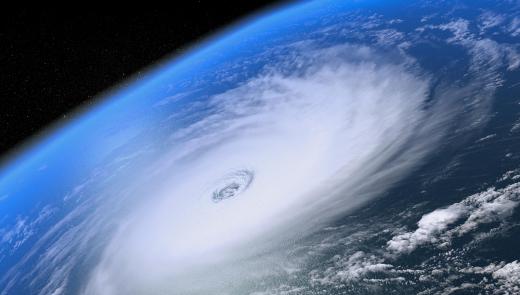
Average daily maximum temperatures are typically about 80 to 90°F (27 - 32°C), but this is affected by altitude, with higher areas being cooler. Annual rainfall generally varies from about 98 inches (249 cm) to about 138 inches (350 cm). There is normally not a great deal of variation in temperature through the year, but rainfall often has a seasonal aspect, as it is affected by ocean currents and factors beyond the region. The rainy and dry seasons vary from place to place, with some areas experiencing high to very high rainfall all year round, and others having distinct relatively dry periods. The high temperatures and abundant moisture found in most equatorial areas have led to the growth of rainforests with a great diversity of plant and animal life.
Interesting Facts
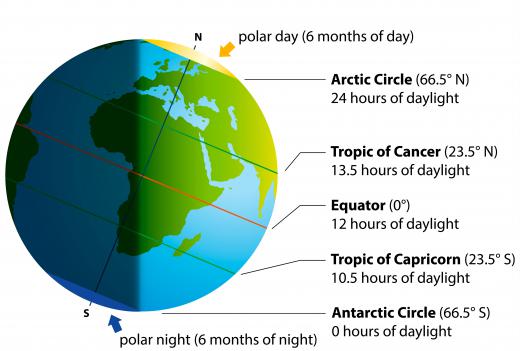
The length of the equator has been measured very accurately by geographers and surveyors. According to a 2000 survey, to within 0.04 inches (1 mm) of accuracy, it is 131,479,775 feet 6.92 inches (40,075,035.535 m). Since the Earth bulges slightly around the middle, the equator is slightly longer than an imaginary circle drawn between the poles. If the heights of mountains are measured in terms of distance from the Earth’s center, instead of the more traditional height above sea level, the worlds’ highest mountain is not Everest, but Chimborazo in Ecuador, whose summit is further from the center of the Earth than that of any other mountain, due to its very low latitude.
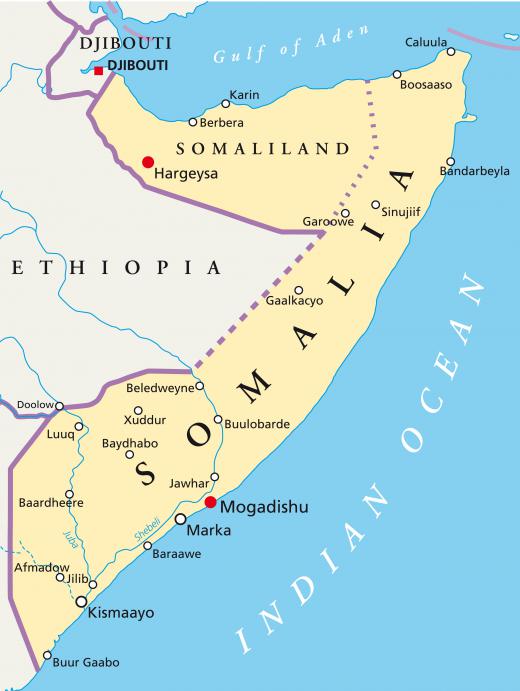
Since the Earth is rotating, a person standing at the equator is traveling faster relative to a person at a high latitude. The speed of rotation at 0° latitude is 1,038 mph (1,670 kph), compared to 0 at the poles. For this reason, the equator is the ideal place to launch a spacecraft, as it is already traveling quite fast prior to launching and so requires less fuel.
The main factor in the formation of hurricanes is ocean temperature: where it is not high enough, they will not form. Although ocean temperatures at 0° latitude are high enough for hurricanes to form, these storms have not been observed to form anywhere within the range 5° north to 5° south. It is thought that this is because the Coriolis force — an influence due to the Earth’s rotation — is not strong enough here to cause the spinning motion required. Hurricanes also appear never to cross the equator, apparently because the Coriolis force always causes them to veer away to the north or south, depending on the hemisphere.
AS FEATURED ON:
AS FEATURED ON:
















Discussion Comments
Those who think the equator is a paradise is not exactly true. You will have to contend with the hot and humid weather if you can stand it. Then comes the wet rainfall. It depends on how you strike a balance between the two.
Thanks so much but you should also say something about the sun having an affect on the equator.
The equator is awful. It's hot and humid all year round.
I really do envy those who live in country with four seasons. Living with constant sun shine and rain is so boring, it's not real life.
PS: Biggest disadvantage? There's no snow. Stinks, right?
@kylee07drg - I also think the consistent temperatures and even hours of daylight and night would be wonderful.
I struggle with seasonal depression during our long, cold winter months. The weather is too cold to get outside and the days are so short that you feel like most of it is in darkness.
It can get depressing when it is dark when you leave for work every day and it is dark when you come home.
Life on the equator sounds like it would be a tropical paradise that I really don't think I would ever get tired of.
I love living in a place where we have four distinct seasons. Each season brings its advantages and disadvantages, but it is never boring.
In the winter I enjoy not worrying about the bugs and taking a reprieve from yard work. I think it would be fascinating to take a trip to the equator, but I wouldn't want to live there.
@OeKc05 - I am one of those people who like to visit the Florida beaches to soak up the sun during the long, cold winters we have.
Taking a trip within the United States is much cheaper than traveling to the equator to enjoy some warmer temperatures.
I have never liked living in a cold climate and always envy the warm temperatures and many days of sunshine that Florida has.
Someday I would love to take a trip and explore the Amazon rainforest. Any time I visit a rainforest at a zoo, I enjoy stepping inside the warm, humid atmosphere and watching all the different animals.
My kids are fascinated by the animals, but after awhile complain of it being too hot. For me, the temperature is just right.
I live on the southern tip of Florida, which is closer to the equator than anywhere else in the continental U.S. This definitely affects the weather here.
We are usually pretty hot in the summer, and even in the winter, we see average temperatures in the seventies. People flock to our beaches during the cold months to get away from all the snow, which they can rest assured they will never see here.
Like places near the equator, we generally see afternoon thunderstorms, particularly along the coast. As the day gets hotter and the humidity higher, the air becomes electric and saturated by late afternoon, and everyone has to go inside for awhile.
I did not know that the land around the equator got twelve hours of daylight all the time! The people there never have to deal with falling back or springing forward an hour. That must be nice.
The time change itself isn't as bad as the fact that the sun naturally starts to set sooner in the fall. Even if we kept the time the same, by November, the sun would be setting here in the southern United States by 5:30 p.m.
Life near the equator sounds like paradise. You never have to sacrifice sunlight and you never have a chilly winter.
@shell4life – I would love to explore land near the equator! I am tired of seeing all the same kinds of birds and animals around here all the time. It would be so awesome to see an animal that I could not even identify.
I have watched documentaries on the wildlife near the equator, and I have seen some pretty crazy looking critters. There are some that I wouldn't even know what category they belong to, because they look like a combination between a weasel and a monkey.
You also see some pretty brightly colored birds down there. I would love to see a parrot or a toucan in person.
This explains why Madagascar is so full of strange animals found nowhere else on Earth. It is just south of the equator, so it is a perfectly warm and moist environment for life to flourish.
It would be interesting to visit a place near the equator, like a rainforest, but I don't think I'd want to live there. Good biodiversity means more dangerous animals and insects are present along with the harmless ones, and I would hate to be afraid to go out into my own yard. All kinds of poisonous snakes and spiders would probably be lurking there.
Imaginary line eh? Figures. Wonder if West/East divide, Third/First world were also made up?
if the equator is an imaginary line, who can really say where is anything? how can any of these studies be taken seriously?
The explanation is excellent. Please also include how the fuel cost will be reduced if spacecraft is launched from the equator.
Post your comments